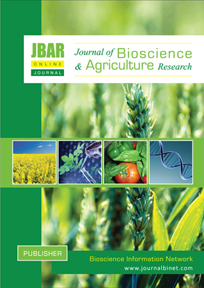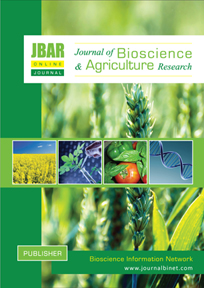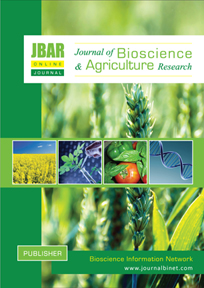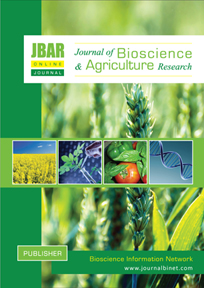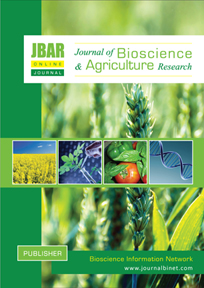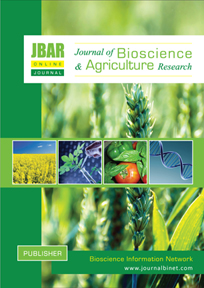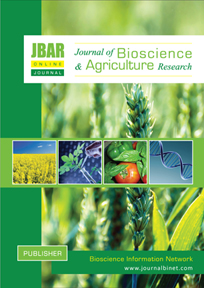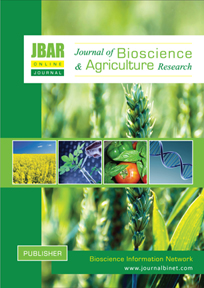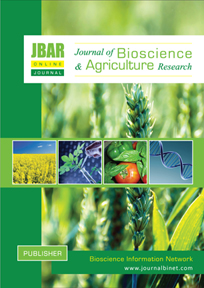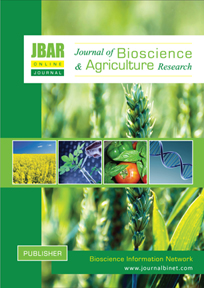Journal of Bioscience and Agriculture Research
Volume 14 - Issue 01 | Year of Publication: 2017
Article Type: Research Article | No. 141, 2017 | Country: Bangladesh | pp. 1151-1156 | Open Access
Title: Farmer attitude towards organic vegetable cultivation in Rangunia Upazila, Chittagong, Bangladesh
Authors: Sohel Rana, Md. Hafiz Hasan, Mohammad Shah Alam and Mohammad Saiful Islam
DOI: https://doi.org/10.18801/jbar.140117.141
Title: Farmer attitude towards organic vegetable cultivation in Rangunia Upazila, Chittagong, Bangladesh
Authors: Sohel Rana, Md. Hafiz Hasan, Mohammad Shah Alam and Mohammad Saiful Islam
DOI: https://doi.org/10.18801/jbar.140117.141
Title: Farmer attitude towards organic vegetable cultivation in Rangunia Upazila, Chittagong, Bangladesh
Abstract: The study was undertaken to determine the attitude of farmers towards organic vegetable cultivation and explore the relationships between their selected characteristics with their attitude. Data were collected through personal interview using pre tested structured questionnaire from a sample of 65 randomly selected vegetable farmers and FGD during January to February 2015 in Pourashava and Sarafvata union under Rangunia upazila of Chittagong district. Attitude was measured against 13 statements regarding organic vegetable cultivation following five point Likert scale. To explore the relationship between the concerned variables correlation coefficient (r) was computed using SPSS. Descriptive statistics were used to describe the variables. Majority of the farmers (95.4%) had positive attitude towards organic vegetable cultivation. Correlation analysis indicates that level of education, extension media contact and agricultural training received had positive and significant relationship with their attitude score.
Key Words: Attitude, vegetable farmers, organic farming and Chittagong
Abstract: The study was undertaken to determine the attitude of farmers towards organic vegetable cultivation and explore the relationships between their selected characteristics with their attitude. Data were collected through personal interview using pre tested structured questionnaire from a sample of 65 randomly selected vegetable farmers and FGD during January to February 2015 in Pourashava and Sarafvata union under Rangunia upazila of Chittagong district. Attitude was measured against 13 statements regarding organic vegetable cultivation following five point Likert scale. To explore the relationship between the concerned variables correlation coefficient (r) was computed using SPSS. Descriptive statistics were used to describe the variables. Majority of the farmers (95.4%) had positive attitude towards organic vegetable cultivation. Correlation analysis indicates that level of education, extension media contact and agricultural training received had positive and significant relationship with their attitude score.
Key Words: Attitude, vegetable farmers, organic farming and Chittagong
HOW TO CITE THIS ARTICLE?
APA (American Psychological Association)
Rana, S., Hasan, M. H., Alam, M. S. and Islam, M. S. (2017). Farmer attitude towards organic vegetable cultivation in Rangunia Upazila, Chittagong, Bangladesh. Journal of Bioscience and Agriculture Research, 14(01), 1151-1156.
MLA (Modern Language Association)
Rana, S., Hasan, M. H., Alam, M. S. and Islam, M. S. "Farmer attitude towards organic vegetable cultivation in Rangunia Upazila, Chittagong, Bangladesh." Journal of Bioscience and Agriculture Research, 14.01(2017), 1151-1156.
Chicago and orTurabian
Rana, S., Hasan, M. H., Alam, M. S. and Islam, M. S. "Farmer attitude towards organic vegetable cultivation in Rangunia Upazila, Chittagong, Bangladesh." Journal of Bioscience and Agriculture Research, 14 no.01(2017), 1151-1156.
APA (American Psychological Association)
Rana, S., Hasan, M. H., Alam, M. S. and Islam, M. S. (2017). Farmer attitude towards organic vegetable cultivation in Rangunia Upazila, Chittagong, Bangladesh. Journal of Bioscience and Agriculture Research, 14(01), 1151-1156.
MLA (Modern Language Association)
Rana, S., Hasan, M. H., Alam, M. S. and Islam, M. S. "Farmer attitude towards organic vegetable cultivation in Rangunia Upazila, Chittagong, Bangladesh." Journal of Bioscience and Agriculture Research, 14.01(2017), 1151-1156.
Chicago and orTurabian
Rana, S., Hasan, M. H., Alam, M. S. and Islam, M. S. "Farmer attitude towards organic vegetable cultivation in Rangunia Upazila, Chittagong, Bangladesh." Journal of Bioscience and Agriculture Research, 14 no.01(2017), 1151-1156.
Article Type: Research Article | No. 142, 2017 | Country: Japan | pp. 1157-1164 | Open Access
Title: Appearance of the non-indigenous mtDNA haplotypes of Rhynchocypris lagowskii in Tohoku, Japan
Authors: Hassan, C. M. M., Ishikawa, T., Seki, S. and Mahmuda, A.
DOI: https://doi.org/10.18801/jbar.140117.142
Title: Appearance of the non-indigenous mtDNA haplotypes of Rhynchocypris lagowskii in Tohoku, Japan
Authors: Hassan, C. M. M., Ishikawa, T., Seki, S. and Mahmuda, A.
DOI: https://doi.org/10.18801/jbar.140117.142
Title: Appearance of the non-indigenous mtDNA haplotypes of Rhynchocypris lagowskii in Tohoku, Japan
Abstract: Classification of fresh water fish cyprinidae is hampered by complexity or lack of morphological diversity. In this study we analyse besed on mtDNA sequences were undertaken to clarify phylogenetic relationship Aburahaya (Rhynchocypris lagowskii) among various site in Tohoku, Japan. Evolutionary rate in cytochrome b gene (Cyt-b) region we examined. To assess genetic structure within these populations we analyzed using statistical parsimony networks and relationships between the populations were examined using a neighbor-joining (NJ) method. Three major geographical groups are found in this study. The most parsimonious network of mtDNA haplotype of aburahaya 19 localities, estimated using the TCS algorithm. In this network also showed three geographical groups. Haplotype 1-32 is one group, haplotype 33-36 is group 2, haplotype 37-53 is group 3 and 54 is out group.
Key Words: Population genetics, mtDNA, Cyprinide, Aburahaya, Geographic groups and Haplotype network
Abstract: Classification of fresh water fish cyprinidae is hampered by complexity or lack of morphological diversity. In this study we analyse besed on mtDNA sequences were undertaken to clarify phylogenetic relationship Aburahaya (Rhynchocypris lagowskii) among various site in Tohoku, Japan. Evolutionary rate in cytochrome b gene (Cyt-b) region we examined. To assess genetic structure within these populations we analyzed using statistical parsimony networks and relationships between the populations were examined using a neighbor-joining (NJ) method. Three major geographical groups are found in this study. The most parsimonious network of mtDNA haplotype of aburahaya 19 localities, estimated using the TCS algorithm. In this network also showed three geographical groups. Haplotype 1-32 is one group, haplotype 33-36 is group 2, haplotype 37-53 is group 3 and 54 is out group.
Key Words: Population genetics, mtDNA, Cyprinide, Aburahaya, Geographic groups and Haplotype network
HOW TO CITE THIS ARTICLE?
APA (American Psychological Association)
Hassan, C. M. M., Ishikawa, T., Seki, S. and Mahmuda, A. (2017). Appearance of the non-indigenous mtDNA haplotypes of Rhynchocypris lagowskii in Tohoku, Japan. Journal of Bioscience and Agriculture Research,14(01),1157-1164.
MLA (Modern Language Association)
Hassan, C. M. M., Ishikawa, T., Seki, S. and Mahmuda, A. “Appearance of the non-indigenous mtDNA haplotypes of Rhynchocypris lagowskii in Tohoku, Japan”. Journal of Bioscience and Agriculture Research, 14.01(2017), 1157-1164.
Chicago and orTurabian
Hassan, C. M. M., Ishikawa, T., Seki, S. and Mahmuda, A. “Appearance of the non-indigenous mtDNA haplotypes of Rhynchocypris lagowskii in Tohoku, Japan”. Journal of Bioscience and Agriculture Research, 14. no. 01(2017), 1157-1164.
APA (American Psychological Association)
Hassan, C. M. M., Ishikawa, T., Seki, S. and Mahmuda, A. (2017). Appearance of the non-indigenous mtDNA haplotypes of Rhynchocypris lagowskii in Tohoku, Japan. Journal of Bioscience and Agriculture Research,14(01),1157-1164.
MLA (Modern Language Association)
Hassan, C. M. M., Ishikawa, T., Seki, S. and Mahmuda, A. “Appearance of the non-indigenous mtDNA haplotypes of Rhynchocypris lagowskii in Tohoku, Japan”. Journal of Bioscience and Agriculture Research, 14.01(2017), 1157-1164.
Chicago and orTurabian
Hassan, C. M. M., Ishikawa, T., Seki, S. and Mahmuda, A. “Appearance of the non-indigenous mtDNA haplotypes of Rhynchocypris lagowskii in Tohoku, Japan”. Journal of Bioscience and Agriculture Research, 14. no. 01(2017), 1157-1164.
Article Type: Research Article | No. 143, 2017 | Country: Bangladesh | pp. 1165-1173 | Open Access
Title: Planting technique of Teli-garjan (Dipterocarpus turbinatus Gaertn.) and Dhaki-jam (Syzygium firmum Thw.) in degraded hills of Chittagong, Bangladesh
Authors: Haider, M. R., Bhowmick, N. G., Begum, N., Zashimuddin, M. and Hoque, M. A.
DOI: https://doi.org/10.18801/jbar.140117.143
Title: Planting technique of Teli-garjan (Dipterocarpus turbinatus Gaertn.) and Dhaki-jam (Syzygium firmum Thw.) in degraded hills of Chittagong, Bangladesh
Authors: Haider, M. R., Bhowmick, N. G., Begum, N., Zashimuddin, M. and Hoque, M. A.
DOI: https://doi.org/10.18801/jbar.140117.143
Title: Planting technique of Teli-garjan (Dipterocarpus turbinatus Gaertn.) and Dhaki-jam (Syzygium firmum Thw.) in degraded hills of Chittagong, Bangladesh
Abstract: Suitable plantation technique is important for establishing plantation of different species from better germination, growth performance, economic and environmental point of view. Two plantation techniques, polybag seedlings and thali (direct seeding on ring shaped cleared soil), were studied from 2005 to 2014 in order to find out the superior one for establishing plantations of Dipterocarpus turbinatus and Syzygium firmum. Results revealed that polybag seedlings of Dipterocarpus turbinatus and Syzygium firmum had little bit higher germination percentage, germination value and germination energy than thali. None of these values of polybag seedlings and thali are significantly different except germination value and germination energy of Dipterocarpus turbinatus. Cumulative germination percentage of both species was higher at the initial stage for polybag seedlings than thali. Growth performance up to 9.5 years of Dipterocarpus turbinatus showed that for polybag seedlings the average height, average diameter at breast height (DBH), mean annual increment (MAI) of height and MAI of DBH are comparatively higher, with no significant difference than thali. On the other hand, these growth parameters of Syzygium firmum are higher for polybag seedlings at 5% significant level than thali. The survival percentage of Dipterocarpus turbinatus was higher (78.67 ± 9.33%) in plantations raised from thali (direct seeding) than polybag raised seedlings (69.33 ± 9.61%). The financial analysis was very positive for thali since expenditure incureed for establishing plantations by thali was much lower (6.70 BDTk./individual) than polybag seedlings (15.60 BDTk./individual). Considering the germination potentiality, growth performances, financial invovement and environmental point of view, the study suggested that the thali technique or direct seeding may be suitable for teli-garjan (Dipterocarpus turbinatus) and dhaki-jam (Syzygium firmum) plantation.
Key Words: Planting technique, Dipterocarpus turbinatus, Syzygium firmum, degraded hills, thali germination, germination value, energy and growth
Abstract: Suitable plantation technique is important for establishing plantation of different species from better germination, growth performance, economic and environmental point of view. Two plantation techniques, polybag seedlings and thali (direct seeding on ring shaped cleared soil), were studied from 2005 to 2014 in order to find out the superior one for establishing plantations of Dipterocarpus turbinatus and Syzygium firmum. Results revealed that polybag seedlings of Dipterocarpus turbinatus and Syzygium firmum had little bit higher germination percentage, germination value and germination energy than thali. None of these values of polybag seedlings and thali are significantly different except germination value and germination energy of Dipterocarpus turbinatus. Cumulative germination percentage of both species was higher at the initial stage for polybag seedlings than thali. Growth performance up to 9.5 years of Dipterocarpus turbinatus showed that for polybag seedlings the average height, average diameter at breast height (DBH), mean annual increment (MAI) of height and MAI of DBH are comparatively higher, with no significant difference than thali. On the other hand, these growth parameters of Syzygium firmum are higher for polybag seedlings at 5% significant level than thali. The survival percentage of Dipterocarpus turbinatus was higher (78.67 ± 9.33%) in plantations raised from thali (direct seeding) than polybag raised seedlings (69.33 ± 9.61%). The financial analysis was very positive for thali since expenditure incureed for establishing plantations by thali was much lower (6.70 BDTk./individual) than polybag seedlings (15.60 BDTk./individual). Considering the germination potentiality, growth performances, financial invovement and environmental point of view, the study suggested that the thali technique or direct seeding may be suitable for teli-garjan (Dipterocarpus turbinatus) and dhaki-jam (Syzygium firmum) plantation.
Key Words: Planting technique, Dipterocarpus turbinatus, Syzygium firmum, degraded hills, thali germination, germination value, energy and growth
HOW TO CITE THIS ARTICLE?
APA (American Psychological Association)
Haider, M. R., Bhowmick, N. G., Begum, N., Zashimuddin, M. and Hoque, M. A. (2017). Planting technique of Teli-garjan (Dipterocarpus turbinatus Gaertn.) and Dhaki-jam (Syzygium firmum Thw.) in degraded hills of Chittagong, Bangladesh. Journal of Bioscience and Agriculture Research,14(01), 1165-1173.
MLA (Modern Language Association)
Haider, M. R., Bhowmick, N. G., Begum, N., Zashimuddin, M. and Hoque, M. A. “Planting technique of Teli-garjan (Dipterocarpus turbinatus Gaertn.) and Dhaki-jam (Syzygium firmum Thw.) in degraded hills of Chittagong, Bangladesh”. Journal of Bioscience and Agriculture Research, 14.01(2017), 1165-1173.
Chicago and orTurabian
Haider, M. R., Bhowmick, N. G., Begum, N., Zashimuddin, M. and Hoque, M. A. “Planting technique of Teli-garjan (Dipterocarpus turbinatus Gaertn.) and Dhaki-jam (Syzygium firmum Thw.) in degraded hills of Chittagong, Bangladesh”. Journal of Bioscience and Agriculture Research, 14. no. 01(2017), 1165-1173.
APA (American Psychological Association)
Haider, M. R., Bhowmick, N. G., Begum, N., Zashimuddin, M. and Hoque, M. A. (2017). Planting technique of Teli-garjan (Dipterocarpus turbinatus Gaertn.) and Dhaki-jam (Syzygium firmum Thw.) in degraded hills of Chittagong, Bangladesh. Journal of Bioscience and Agriculture Research,14(01), 1165-1173.
MLA (Modern Language Association)
Haider, M. R., Bhowmick, N. G., Begum, N., Zashimuddin, M. and Hoque, M. A. “Planting technique of Teli-garjan (Dipterocarpus turbinatus Gaertn.) and Dhaki-jam (Syzygium firmum Thw.) in degraded hills of Chittagong, Bangladesh”. Journal of Bioscience and Agriculture Research, 14.01(2017), 1165-1173.
Chicago and orTurabian
Haider, M. R., Bhowmick, N. G., Begum, N., Zashimuddin, M. and Hoque, M. A. “Planting technique of Teli-garjan (Dipterocarpus turbinatus Gaertn.) and Dhaki-jam (Syzygium firmum Thw.) in degraded hills of Chittagong, Bangladesh”. Journal of Bioscience and Agriculture Research, 14. no. 01(2017), 1165-1173.
Article Type: Research Article | No. 144, 2017 | Country: Bangladesh | pp. 1174-1182 | Open Access
Title: Productivity and profitability of mandarin cultivation in selected areas of Bangladesh
Authors: M. I. Kaysar, S. Khandoker, M. S. Islam, M. S. Mia and A. K. M. G. Kausar
DOI: https://doi.org/10.18801/jbar.140117.144
Title: Productivity and profitability of mandarin cultivation in selected areas of Bangladesh
Authors: M. I. Kaysar, S. Khandoker, M. S. Islam, M. S. Mia and A. K. M. G. Kausar
DOI: https://doi.org/10.18801/jbar.140117.144
Title: Productivity and profitability of mandarin cultivation in selected areas of Bangladesh
Abstract: The study was conducted in three districts namely Panchagarh, Bandarban and Moulovibazar to know the production technology of mandarin cultivation and to estimate profitability and identify the constraints of mandarin cultivation. A total of 99 farmers taking 33 from each district were selected randomly. Data were collected through a pre-tested schedule during January-March, 2016. Cost and return analysis revealed that mandarin cultivation was profitable in the study areas. The highest cost was estimated Tk. 215293/ha in 16-20th year garden and lowest cost Tk. 119993/ha in 2-4th year garden. Highest yield was found 16020 kg/ha at 11-15th year garden followed by 13800 kg/ha at 16-20th year garden and lowest yield 11100 kg/ha at 5-10th year garden. The highest gross return was found in Tk. 640800/ha at 11-15th year garden and lowest return was Tk. 444000 at 5-10th year garden. The highest amount of net return was found in the Tk. 435859/ha at 11-15th year garden and lowest return was Tk. 235286 in 5-10th year garden. The benefit cost ratio at 12% rate of interest was 1.68, NPV Tk. 920401 and IRR 30%. Sensitivity analysis implied that mandarin cultivation is profitable. Scarcity of irrigation in hill areas, acute problem of insect/pest infestation, lack of improved production technology, poor quality and scarcity of seedlings/saplings, lack of capital for initial investment and low yield of different varieties were found major constraints for mandarin cultivation in the study areas.
Key Words: Mandarin, profitability, Socio-economic status, Constraints and Recommendation
Abstract: The study was conducted in three districts namely Panchagarh, Bandarban and Moulovibazar to know the production technology of mandarin cultivation and to estimate profitability and identify the constraints of mandarin cultivation. A total of 99 farmers taking 33 from each district were selected randomly. Data were collected through a pre-tested schedule during January-March, 2016. Cost and return analysis revealed that mandarin cultivation was profitable in the study areas. The highest cost was estimated Tk. 215293/ha in 16-20th year garden and lowest cost Tk. 119993/ha in 2-4th year garden. Highest yield was found 16020 kg/ha at 11-15th year garden followed by 13800 kg/ha at 16-20th year garden and lowest yield 11100 kg/ha at 5-10th year garden. The highest gross return was found in Tk. 640800/ha at 11-15th year garden and lowest return was Tk. 444000 at 5-10th year garden. The highest amount of net return was found in the Tk. 435859/ha at 11-15th year garden and lowest return was Tk. 235286 in 5-10th year garden. The benefit cost ratio at 12% rate of interest was 1.68, NPV Tk. 920401 and IRR 30%. Sensitivity analysis implied that mandarin cultivation is profitable. Scarcity of irrigation in hill areas, acute problem of insect/pest infestation, lack of improved production technology, poor quality and scarcity of seedlings/saplings, lack of capital for initial investment and low yield of different varieties were found major constraints for mandarin cultivation in the study areas.
Key Words: Mandarin, profitability, Socio-economic status, Constraints and Recommendation
HOW TO CITE THIS ARTICLE?
APA (American Psychological Association)
Kaysar, M. I. , khandoker, S., Islam, M. S., Mia, M. S. and Kausar, A. K. M. G. (2017). Productivity and profitability of mandarin cultivation in selected areas of Bangladesh. Journal of Bioscience and Agriculture Research, 14(01), 1174-1182.
MLA (Modern Language Association)
Kaysar, M. I. , khandoker, S., Islam, M. S., Mia, M. S. and Kausar, A. K. M. G. “Productivity and profitability of mandarin cultivation in selected areas of Bangladesh”. Journal of Bioscience and Agriculture Research, 14.01(2017): 1174-1182.
Chicago and or Turabian
Kaysar, M. I. , khandoker, S., Islam, M. S., Mia, M. S. and Kausar, A. K. M. G. “Productivity and profitability of mandarin cultivation inselected areas of Bangladesh”. Journal of Bioscience and Agriculture Research, 14. no.01(2017): 1174-1182.
APA (American Psychological Association)
Kaysar, M. I. , khandoker, S., Islam, M. S., Mia, M. S. and Kausar, A. K. M. G. (2017). Productivity and profitability of mandarin cultivation in selected areas of Bangladesh. Journal of Bioscience and Agriculture Research, 14(01), 1174-1182.
MLA (Modern Language Association)
Kaysar, M. I. , khandoker, S., Islam, M. S., Mia, M. S. and Kausar, A. K. M. G. “Productivity and profitability of mandarin cultivation in selected areas of Bangladesh”. Journal of Bioscience and Agriculture Research, 14.01(2017): 1174-1182.
Chicago and or Turabian
Kaysar, M. I. , khandoker, S., Islam, M. S., Mia, M. S. and Kausar, A. K. M. G. “Productivity and profitability of mandarin cultivation inselected areas of Bangladesh”. Journal of Bioscience and Agriculture Research, 14. no.01(2017): 1174-1182.
Article Type: Research Article | No. 145, 2017 | Country: Bangladesh | pp. 1183-1189 | Open Access
Title: Effect of organic fertilizers on major insect infestation in two cabbage cultivars
Authors: Md. Jamal Hossain, Golam Mostofa Khan, Md. Giash Uddin, Md. Tanzilur Rahman and K. M. Mehadi Hassan
DOI: https://doi.org/10.18801/jbar.140117.145
Title: Effect of organic fertilizers on major insect infestation in two cabbage cultivars
Authors: Md. Jamal Hossain, Golam Mostofa Khan, Md. Giash Uddin, Md. Tanzilur Rahman and K. M. Mehadi Hassan
DOI: https://doi.org/10.18801/jbar.140117.145
Title: Effect of organic fertilizers on major insect infestation in two cabbage cultivars
Abstract: Organic fertilizers are alterations aiming to improve soil fertility have been found to increase pest populations on cabbage plants. This study was conducted to evaluate the effects of organic fertilizers and weather factors on insect infestation with cabbage cultivars during rabi season of 2007-2008. Two cabbage varieties viz., Atlas 70 and Super tropic and organic fertilizers like control, cowdung, mustard oilcake, Vermicompost and Trichoderma were included in this study. Results revealed that the minimum no. of infested plants plot-1, infested leaves plant-1 and percent infested leaves plant-1 were found in variety super tropic with Trichoderma applied plots on different dates of observation while the maximum no. of infested plants plot-1, infested leaves plant-1 and percent infested leaves plant-1 were in variety super tropic and mustard oil cake applied plots. The highest number and percent (4.00 plot-1) and (20.00% plot-1) of infested heads were found in variety Super tropic and mustard oil cake applied plots. Highest number of healthy heads plot-1 (19.67), healthy head yield (71.47 ton/ha) and total head yield (72.14 ton/ha) were recorded in variety Super tropic and Trichoderma applied plots while the lowest number of healthy heads plot-1, healthy head yield and total head yield were recorded in in variety Super tropic and mustard oil cake applied plots. So application of Trichoderma with Super tropic cultivar ensures low insect infestation and better head yield.
Key Words: Cabbage, Varieties, Infestation, Trichoderma and Vermicompost
Abstract: Organic fertilizers are alterations aiming to improve soil fertility have been found to increase pest populations on cabbage plants. This study was conducted to evaluate the effects of organic fertilizers and weather factors on insect infestation with cabbage cultivars during rabi season of 2007-2008. Two cabbage varieties viz., Atlas 70 and Super tropic and organic fertilizers like control, cowdung, mustard oilcake, Vermicompost and Trichoderma were included in this study. Results revealed that the minimum no. of infested plants plot-1, infested leaves plant-1 and percent infested leaves plant-1 were found in variety super tropic with Trichoderma applied plots on different dates of observation while the maximum no. of infested plants plot-1, infested leaves plant-1 and percent infested leaves plant-1 were in variety super tropic and mustard oil cake applied plots. The highest number and percent (4.00 plot-1) and (20.00% plot-1) of infested heads were found in variety Super tropic and mustard oil cake applied plots. Highest number of healthy heads plot-1 (19.67), healthy head yield (71.47 ton/ha) and total head yield (72.14 ton/ha) were recorded in variety Super tropic and Trichoderma applied plots while the lowest number of healthy heads plot-1, healthy head yield and total head yield were recorded in in variety Super tropic and mustard oil cake applied plots. So application of Trichoderma with Super tropic cultivar ensures low insect infestation and better head yield.
Key Words: Cabbage, Varieties, Infestation, Trichoderma and Vermicompost
HOW TO CITE THIS ARTICLE?
APA (American Psychological Association)
Hossain, M. J., Khan , G. M., Uddin, M. G., Rahman, M. T. and Hassan, K. M. M. (2017). Effect of organic fertilizers on major insect infestation in two cabbage cultivars. Bangladesh. Journal of Bioscience and Agriculture Research,14(01), 1183-1189.
MLA (Modern Language Association)
Hossain, M. J., Khan , G. M., Uddin, M. G., Rahman, M. T. and Hassan, K. M. M. “Effect of organic fertilizers on major insect infestation in two cabbage cultivars”. Bangladesh. Journal of Bioscience and Agriculture Research,14.01(2017): 1183-1189.
Chicago and or Turabian
Hossain, M. J., Khan , G. M., Uddin, M. G., Rahman, M. T. and Hassan, K. M. M. “Effect of organic fertilizers on major insect infestation in two cabbage cultivars”. Bangladesh. Journal of Bioscience and Agriculture Research,14.no.01(2017): 1183-1189.
APA (American Psychological Association)
Hossain, M. J., Khan , G. M., Uddin, M. G., Rahman, M. T. and Hassan, K. M. M. (2017). Effect of organic fertilizers on major insect infestation in two cabbage cultivars. Bangladesh. Journal of Bioscience and Agriculture Research,14(01), 1183-1189.
MLA (Modern Language Association)
Hossain, M. J., Khan , G. M., Uddin, M. G., Rahman, M. T. and Hassan, K. M. M. “Effect of organic fertilizers on major insect infestation in two cabbage cultivars”. Bangladesh. Journal of Bioscience and Agriculture Research,14.01(2017): 1183-1189.
Chicago and or Turabian
Hossain, M. J., Khan , G. M., Uddin, M. G., Rahman, M. T. and Hassan, K. M. M. “Effect of organic fertilizers on major insect infestation in two cabbage cultivars”. Bangladesh. Journal of Bioscience and Agriculture Research,14.no.01(2017): 1183-1189.
Article Type: Research Article | No. 146, 2017 | Country: Bangladesh | pp. 1190-1193 | Open Access
Title: Organic amendment and mulch on yield of onion
Authors: Ahmmed, M. M. , Hossain, F. and Quddus, A. F. M. R.
DOI: https://doi.org/10.18801/jbar.140117.146
Title: Organic amendment and mulch on yield of onion
Authors: Ahmmed, M. M. , Hossain, F. and Quddus, A. F. M. R.
DOI: https://doi.org/10.18801/jbar.140117.146
Title: Organic amendment and mulch on yield of onion
Abstract: An experiment was conducted at a farmer field in Saltha upazilla of Faridpur district, Bangladesh to evaluate the influence of organic amendment and mulch on the growth and yield of onion (Allium cepa) cv. Taherpuri. The experiment was laid out in randomized complete block design (RCBD) with four replications. Treatments were no organic amendment and no mulch or control (T0), mulch (T1), organic amendment (T2) and organic amendment + mulch (T3). Results indicated that leaves per plant, plant height, diameter of bulb, single bulb weight and bulb yield were increased significantly with the application of organic amendment and mulch. Yield contributing characters and yield was found in ascending order (T0 <T1 <T2 <T3). The value of nitrogen, potassium and boron were increased without changing status where organic matter, phosphorous, sulpher and zinc amount reserved sharply.
Key Words: Onion, Mulch, Organic amendment and Nutrients
Abstract: An experiment was conducted at a farmer field in Saltha upazilla of Faridpur district, Bangladesh to evaluate the influence of organic amendment and mulch on the growth and yield of onion (Allium cepa) cv. Taherpuri. The experiment was laid out in randomized complete block design (RCBD) with four replications. Treatments were no organic amendment and no mulch or control (T0), mulch (T1), organic amendment (T2) and organic amendment + mulch (T3). Results indicated that leaves per plant, plant height, diameter of bulb, single bulb weight and bulb yield were increased significantly with the application of organic amendment and mulch. Yield contributing characters and yield was found in ascending order (T0 <T1 <T2 <T3). The value of nitrogen, potassium and boron were increased without changing status where organic matter, phosphorous, sulpher and zinc amount reserved sharply.
Key Words: Onion, Mulch, Organic amendment and Nutrients
HOW TO CITE THIS ARTICLE?
APA (American Psychological Association)
Ahmmed, M. M., Hossain, F. and Quddus, A. F. M. R. (2017). Organic amendment and mulch on yield of onion. Journal of Bioscience and Agriculture Research, 14(01), 1190-1193.
MLA (Modern Language Association)
Ahmmed, M. M., Hossain, F. and Quddus, A. F. M. R. "Organic amendment and mulch on yield of onion". Journal of Bioscience and Agriculture Research, 14.01(2017), 1190-1193.
Chicago and orTurabian
Ahmmed, M. M., Hossain, F. and Quddus, A. F. M. R. "Organic amendment and mulch on yield of onion". Journal of Bioscience and Agriculture Research, 14. no. 01(2017), 1190-1193.
APA (American Psychological Association)
Ahmmed, M. M., Hossain, F. and Quddus, A. F. M. R. (2017). Organic amendment and mulch on yield of onion. Journal of Bioscience and Agriculture Research, 14(01), 1190-1193.
MLA (Modern Language Association)
Ahmmed, M. M., Hossain, F. and Quddus, A. F. M. R. "Organic amendment and mulch on yield of onion". Journal of Bioscience and Agriculture Research, 14.01(2017), 1190-1193.
Chicago and orTurabian
Ahmmed, M. M., Hossain, F. and Quddus, A. F. M. R. "Organic amendment and mulch on yield of onion". Journal of Bioscience and Agriculture Research, 14. no. 01(2017), 1190-1193.
Volume 14 - Issue 02 | Year of Publication: 2017
Article Type: Research Article | No. 147, 2017 | Country: Nepal | pp. 1194-1201 | Open Access
Title: Bio-control ability of Trichoderma species against spot blotch disease (wheat) causing pathogen Bipolaris sorokiniana under in vitro condition
Authors: Bhandari, D.
DOI: https://doi.org/10.18801/jbar.140217.147
Title: Bio-control ability of Trichoderma species against spot blotch disease (wheat) causing pathogen Bipolaris sorokiniana under in vitro condition
Authors: Bhandari, D.
DOI: https://doi.org/10.18801/jbar.140217.147
Title: Bio-control ability of Trichoderma species against spot blotch disease (wheat) causing pathogen Bipolaris sorokiniana under in vitro condition
Abstract: Spot blotch disease of wheat caused by Bipolaris sorokiniana (Shoem.) occurs every year in plain areas of Nepal causing considerable losses of grain yield. Several Trichoderma species possess antagonistic ability against different pathogens. In-vitro studies were conducted to explore the natural antagonistic aptitude of selected Trichoderma species against B. sorokiniana. Dual culture technique was followed to assess the antagonistic ability of five isolates of Trichoderma species against the pathogen. The experiment was conducted following Completely Randomized Design (CRD) with four replications. Radial growth of B. sorokiniana in dual culture with selected isolates of Trichoderma species was measured to compare the antagonistic ability of the selected Trichoderma species. Effects of interaction on viability of mycelium and on sporulation ability of the pathogen were assessed. Prominent antagonistic ability of Trichoderma species was identified from in-vitro dual culture studies. The evaluation of five isolates of Trichoderma species revealed that all the isolates significantly reduced the growth of B. sorokiniana in dual culture. Trichoderma sp. significantly inhibited the growth of B. sorokiniana by entirely covering the colony without completely killing the mycelia; however, the B. sorokiniana’s mycelia obtained from overlapped area of the isolates had significantly lower viability than the control. Trichoderma species also significantly reduced the sporulation ability of B. sorokiniana. The tested isolates of Trichoderma spp. had sturdy antagonistic ability against B. sorokiniana under in vitro condition. However, to exploit the isolates for bio-control of spot blotch disease under field conditions, further studies under in-vivo conditions must be needed.
Key Words: Antagonist, Dual culture, Radial growth, Sporulation and Viability
Abstract: Spot blotch disease of wheat caused by Bipolaris sorokiniana (Shoem.) occurs every year in plain areas of Nepal causing considerable losses of grain yield. Several Trichoderma species possess antagonistic ability against different pathogens. In-vitro studies were conducted to explore the natural antagonistic aptitude of selected Trichoderma species against B. sorokiniana. Dual culture technique was followed to assess the antagonistic ability of five isolates of Trichoderma species against the pathogen. The experiment was conducted following Completely Randomized Design (CRD) with four replications. Radial growth of B. sorokiniana in dual culture with selected isolates of Trichoderma species was measured to compare the antagonistic ability of the selected Trichoderma species. Effects of interaction on viability of mycelium and on sporulation ability of the pathogen were assessed. Prominent antagonistic ability of Trichoderma species was identified from in-vitro dual culture studies. The evaluation of five isolates of Trichoderma species revealed that all the isolates significantly reduced the growth of B. sorokiniana in dual culture. Trichoderma sp. significantly inhibited the growth of B. sorokiniana by entirely covering the colony without completely killing the mycelia; however, the B. sorokiniana’s mycelia obtained from overlapped area of the isolates had significantly lower viability than the control. Trichoderma species also significantly reduced the sporulation ability of B. sorokiniana. The tested isolates of Trichoderma spp. had sturdy antagonistic ability against B. sorokiniana under in vitro condition. However, to exploit the isolates for bio-control of spot blotch disease under field conditions, further studies under in-vivo conditions must be needed.
Key Words: Antagonist, Dual culture, Radial growth, Sporulation and Viability
HOW TO CITE THIS ARTICLE?
APA (American Psychological Association)
Bhandari, D. (2017). Bio-control ability of Trichoderma species against spot blotch disease (wheat) causing pathogen Bipolaris sorokiniana under in vitro condition. Journal of Bioscience and Agriculture Research,14(02), 1194-1201.
MLA (Modern Language Association)
Bhandari, D. “Bio-control ability of Trichoderma species against spot blotch disease (wheat) causing pathogen Bipolaris sorokiniana under in vitro condition”. Journal of Bioscience and Agriculture Research, 14.02(2017), 1194-1201.
Chicago and orTurabian
Bhandari, D. “Bio-control ability of Trichoderma species against spot blotch disease (wheat) causing pathogen Bipolaris sorokiniana under in vitro condition”. Journal of Bioscience and Agriculture Research, 14. no. 02(2017), 1194-1201.
APA (American Psychological Association)
Bhandari, D. (2017). Bio-control ability of Trichoderma species against spot blotch disease (wheat) causing pathogen Bipolaris sorokiniana under in vitro condition. Journal of Bioscience and Agriculture Research,14(02), 1194-1201.
MLA (Modern Language Association)
Bhandari, D. “Bio-control ability of Trichoderma species against spot blotch disease (wheat) causing pathogen Bipolaris sorokiniana under in vitro condition”. Journal of Bioscience and Agriculture Research, 14.02(2017), 1194-1201.
Chicago and orTurabian
Bhandari, D. “Bio-control ability of Trichoderma species against spot blotch disease (wheat) causing pathogen Bipolaris sorokiniana under in vitro condition”. Journal of Bioscience and Agriculture Research, 14. no. 02(2017), 1194-1201.
Article Type: Research Article | No. 148, 2017 | Country: Bangladesh | pp. 1202-1209 | Open Access
Title: Multiple cropping for sustainable and exaggerated agricultural production system
Authors: Hossain, M. S., Kader, M. A. and Islam, N.
DOI: https://doi.org/10.18801/jbar.140217.148
Title: Multiple cropping for sustainable and exaggerated agricultural production system
Authors: Hossain, M. S., Kader, M. A. and Islam, N.
DOI: https://doi.org/10.18801/jbar.140217.148
Title: Multiple cropping for sustainable and exaggerated agricultural production system
Abstract: Multiple cropping is a farming practice involving two or more crop species or genotypes growing together and coexisting for a certain period. It is getting importance as farmers intensifying land use to remain competitive and provide the increasing world demand for different crop originated products and in many subsistence or low-input/resource-limited agricultural systems on the fringes of modern intensive agriculture. By providing actual yield gains without increased inputs, or greater stability of yield with decreased inputs, multiple cropping becomes one unique route to delivering sustainable intensification. Innovations by agricultural scientists in pesticides, no-till instrumentation, rotation of legumes and grasses for tap-rooted and fibrous -rooted crops, and breeding crops tailored to specific systems and environments create intensified multiple cropping farming more successful. With this connection, the experiment was carried out to study effect of intercropping combinations (rice with four different vegetables) on land use efficiency using the Land Equivalent Ratio (LER) and total return per unit area based on benefit-cost ratio (BCR). Intercropping combinations had significant effect on LER and BCR for total return. Result showed that the lowest cost of production was found in sole rice under monoculture compared to all other cases of polyculture. But sole rice cultivation under monoculture is less profitable than the production of vegetable-rice intercropping. Vegetable cultivation along with rice crop is remunerative in both yield and economical point of view.
Key Words: Benefit-cost ratio, Land equivalent ratio, Multiple cropping, Rice, Vegetable and Yield
Abstract: Multiple cropping is a farming practice involving two or more crop species or genotypes growing together and coexisting for a certain period. It is getting importance as farmers intensifying land use to remain competitive and provide the increasing world demand for different crop originated products and in many subsistence or low-input/resource-limited agricultural systems on the fringes of modern intensive agriculture. By providing actual yield gains without increased inputs, or greater stability of yield with decreased inputs, multiple cropping becomes one unique route to delivering sustainable intensification. Innovations by agricultural scientists in pesticides, no-till instrumentation, rotation of legumes and grasses for tap-rooted and fibrous -rooted crops, and breeding crops tailored to specific systems and environments create intensified multiple cropping farming more successful. With this connection, the experiment was carried out to study effect of intercropping combinations (rice with four different vegetables) on land use efficiency using the Land Equivalent Ratio (LER) and total return per unit area based on benefit-cost ratio (BCR). Intercropping combinations had significant effect on LER and BCR for total return. Result showed that the lowest cost of production was found in sole rice under monoculture compared to all other cases of polyculture. But sole rice cultivation under monoculture is less profitable than the production of vegetable-rice intercropping. Vegetable cultivation along with rice crop is remunerative in both yield and economical point of view.
Key Words: Benefit-cost ratio, Land equivalent ratio, Multiple cropping, Rice, Vegetable and Yield
HOW TO CITE THIS ARTICLE?
APA (American Psychological Association)
Hossain, M. S., Kader, M. A. and Islam, N. (2017). Multiple cropping for sustainable and exaggerated agricultural production system. Journal of Bioscience and Agriculture Research, 14(02), 1202-1209.
MLA (Modern Language Association)
Hossain, M. S., Kader, M. A. and Islam, N. “Multiple cropping for sustainable and exaggerated agricultural production system”. Journal of Bioscience and Agriculture Research, 14.02(2017), 1202-1209.
Chicago and orTurabian
Hossain, M. S., Kader, M. A. and Islam, N. “Multiple cropping for sustainable and exaggerated agricultural production system”. Journal of Bioscience and Agriculture Research, 14. no. 02(2017), 1202-1209.
APA (American Psychological Association)
Hossain, M. S., Kader, M. A. and Islam, N. (2017). Multiple cropping for sustainable and exaggerated agricultural production system. Journal of Bioscience and Agriculture Research, 14(02), 1202-1209.
MLA (Modern Language Association)
Hossain, M. S., Kader, M. A. and Islam, N. “Multiple cropping for sustainable and exaggerated agricultural production system”. Journal of Bioscience and Agriculture Research, 14.02(2017), 1202-1209.
Chicago and orTurabian
Hossain, M. S., Kader, M. A. and Islam, N. “Multiple cropping for sustainable and exaggerated agricultural production system”. Journal of Bioscience and Agriculture Research, 14. no. 02(2017), 1202-1209.
Article Type: Research Article | No. 149, 2017 | Country: Iran | pp. 1210-1221 | Open Access
Title: Effects of priming and mycorrhiza on improving balance of sodium and potassium and changes of antioxidants in leaves of maize under soil salinity
Authors: Kazemi, J. S., Aboutalebian, M. A. and Mesgarbashee, M.
DOI: https://doi.org/10.18801/jbar.140217.149
Title: Effects of priming and mycorrhiza on improving balance of sodium and potassium and changes of antioxidants in leaves of maize under soil salinity
Authors: Kazemi, J. S., Aboutalebian, M. A. and Mesgarbashee, M.
DOI: https://doi.org/10.18801/jbar.140217.149
Title: Effects of priming and mycorrhiza on improving balance of sodium and potassium and changes of antioxidants in leaves of maize under soil salinity
Abstract: For study the effects of priming and mycorrhiza on improving the balance of sodium and potassium and some changes antioxidants in the leaves of maize under soil salinity. This experiment was laid out in a randomized complete block design as factorial with three replications in two years 2014/15- 2015/16 in two place of saline and non-saline on hybrid corn NS640. The first factor inoculated and non-inoculated with mycorrhiza (Glomus mossea), the second factor in four level osmopriming with Nacl solution, priming with salicylic acid, priming with tap water and non-prime(control). Solutions concentration and Prime duration were determined in separate experiments. The results showed that the enzymes catalase and peroxidase, Superoxide dismutase, soluble proteins and potassium increased in leaves in both the saline and non-saline, inoculation with mycorrhiza and primed with salicylic acid than non-inoculation and non-primed that this increasing in saline soils was more. The sodium in inoculation with mycorrhiza and prime with salicylic acid than non-prime and non-inoculation in both the saline and non-saline especially saline environment is leading to a decrease in leaf. Colonization percent, the percentage of emergence and emergence rate of inoculation with mycorrhiza and primed with salicylic acid than non-inoculation and non-prime in both environments has been increasing, especially in non-saline environment.
Key Words: Salicylic acid, Salt, Tap water and Percentage of colonization
Abstract: For study the effects of priming and mycorrhiza on improving the balance of sodium and potassium and some changes antioxidants in the leaves of maize under soil salinity. This experiment was laid out in a randomized complete block design as factorial with three replications in two years 2014/15- 2015/16 in two place of saline and non-saline on hybrid corn NS640. The first factor inoculated and non-inoculated with mycorrhiza (Glomus mossea), the second factor in four level osmopriming with Nacl solution, priming with salicylic acid, priming with tap water and non-prime(control). Solutions concentration and Prime duration were determined in separate experiments. The results showed that the enzymes catalase and peroxidase, Superoxide dismutase, soluble proteins and potassium increased in leaves in both the saline and non-saline, inoculation with mycorrhiza and primed with salicylic acid than non-inoculation and non-primed that this increasing in saline soils was more. The sodium in inoculation with mycorrhiza and prime with salicylic acid than non-prime and non-inoculation in both the saline and non-saline especially saline environment is leading to a decrease in leaf. Colonization percent, the percentage of emergence and emergence rate of inoculation with mycorrhiza and primed with salicylic acid than non-inoculation and non-prime in both environments has been increasing, especially in non-saline environment.
Key Words: Salicylic acid, Salt, Tap water and Percentage of colonization
HOW TO CITE THIS ARTICLE?
APA (American Psychological Association)
Kazemi, J. S., Aboutalebian, M. A. and Mesgarbashee, M. (2017). Effects of priming and mycorrhiza on improving balance of sodium and potassium and changes of antioxidants in leaves of maize under soil salinity. Journal of Bioscience and Agriculture Research,14(02),1210-1221.
MLA (Modern Language Association)
Kazemi, J. S., Aboutalebian, M. A. and Mesgarbashee, M. “Effects of priming and mycorrhiza on improving balance of sodium and potassium and changes of antioxidants in leaves of maize under soil salinity”. Journal of Bioscience and Agriculture Research, 14.02(2017), 1210-1221.
Chicago and orTurabian
Kazemi, J. S., Aboutalebian, M. A. and Mesgarbashee, M. “Effects of priming and mycorrhiza on improving balance of sodium and potassium and changes of antioxidants in leaves of maize under soil salinity”. Journal of Bioscience and Agriculture Research, 14. no. 02(2017), 1210-1221.
APA (American Psychological Association)
Kazemi, J. S., Aboutalebian, M. A. and Mesgarbashee, M. (2017). Effects of priming and mycorrhiza on improving balance of sodium and potassium and changes of antioxidants in leaves of maize under soil salinity. Journal of Bioscience and Agriculture Research,14(02),1210-1221.
MLA (Modern Language Association)
Kazemi, J. S., Aboutalebian, M. A. and Mesgarbashee, M. “Effects of priming and mycorrhiza on improving balance of sodium and potassium and changes of antioxidants in leaves of maize under soil salinity”. Journal of Bioscience and Agriculture Research, 14.02(2017), 1210-1221.
Chicago and orTurabian
Kazemi, J. S., Aboutalebian, M. A. and Mesgarbashee, M. “Effects of priming and mycorrhiza on improving balance of sodium and potassium and changes of antioxidants in leaves of maize under soil salinity”. Journal of Bioscience and Agriculture Research, 14. no. 02(2017), 1210-1221.
Article Type: Research Article | No. 150, 2017 | Country: Ethiopia | pp. 1222-1230 | Open Access
Title: Effects of water erosion on soil chemical loss under different tillage and cropping system in clay loam soil at Assosa, Ethiopia
Authors: Adugna, O., Quarishi, S. and Bedadi, B.
DOI: https://doi.org/10.18801/jbar.140217.150
Title: Effects of water erosion on soil chemical loss under different tillage and cropping system in clay loam soil at Assosa, Ethiopia
Authors: Adugna, O., Quarishi, S. and Bedadi, B.
DOI: https://doi.org/10.18801/jbar.140217.150
Title: Effects of water erosion on soil chemical loss under different tillage and cropping system in clay loam soil at Assosa, Ethiopia
Abstract: Soil erosion affects the sustainable use of soil resources through its influence on soil properties. Proper use of tillage can improve soil related constraints, while improper tillage may cause a range of undesirable processes. Conservation tillage like no tillage had been reported to improve the properties of the soil. Thus, the study had been carried out at Assosa Agricultural research center to evaluate the effects of tillage and cropping system on soil chemical and in situ moisture conservation. Eighteen experimental runoff plots of 8 m long and 3 m wide each were framed with corrugated iron sheets. The experimental design used was randomized complete block design (RCBD) with six treatment in factorial combinations vis-à-vis three cropping systems (sole maize, sole soya bean and intercropping of maize with soya bean), with tillage system (no tillage and convectional tillage), that were replicated three times. The treatments had shown non-significant variation for all parameters showing Enrichment ratio of ≥ 1 except some no tillage treatments. Higher enrichment ratios for clay and silt fraction were observed under conventional tillage treatments and thereby high loss of nutrients like nitrogen, available phosphorus, and organic carbon than no tillage treatments. No tillage with soya bean and no tillage with intercropping treatments had shown the value of ≤ 1 for total nitrogen and phosphorus than conventional tillage treatments. No tillage treatments in concomitant with cropping system especially intercropping had retained more nutrients than conventional tillage by reducing runoff and soil loss to Enrichment ratio of ≤ 1.This study revealed the potential of no tillage with mulch to reduce nutrient losses and enrichment ratio.
Key Words: Water erosion, Tillage, Soil nutrients and Land degradation
Abstract: Soil erosion affects the sustainable use of soil resources through its influence on soil properties. Proper use of tillage can improve soil related constraints, while improper tillage may cause a range of undesirable processes. Conservation tillage like no tillage had been reported to improve the properties of the soil. Thus, the study had been carried out at Assosa Agricultural research center to evaluate the effects of tillage and cropping system on soil chemical and in situ moisture conservation. Eighteen experimental runoff plots of 8 m long and 3 m wide each were framed with corrugated iron sheets. The experimental design used was randomized complete block design (RCBD) with six treatment in factorial combinations vis-à-vis three cropping systems (sole maize, sole soya bean and intercropping of maize with soya bean), with tillage system (no tillage and convectional tillage), that were replicated three times. The treatments had shown non-significant variation for all parameters showing Enrichment ratio of ≥ 1 except some no tillage treatments. Higher enrichment ratios for clay and silt fraction were observed under conventional tillage treatments and thereby high loss of nutrients like nitrogen, available phosphorus, and organic carbon than no tillage treatments. No tillage with soya bean and no tillage with intercropping treatments had shown the value of ≤ 1 for total nitrogen and phosphorus than conventional tillage treatments. No tillage treatments in concomitant with cropping system especially intercropping had retained more nutrients than conventional tillage by reducing runoff and soil loss to Enrichment ratio of ≤ 1.This study revealed the potential of no tillage with mulch to reduce nutrient losses and enrichment ratio.
Key Words: Water erosion, Tillage, Soil nutrients and Land degradation
HOW TO CITE THIS ARTICLE?
APA (American Psychological Association)
Adugna, O., Quarishi, S. and Bedadi, B. (2017). Effects of water erosion on soil chemical loss under different tillage and cropping system in clay loam soil at Assosa, Ethiopia. Journal of Bioscience and Agriculture Research,14(02), 1222-1230.
MLA (Modern Language Association)
Adugna, O., Quarishi, S. and Bedadi, B. “Effects of water erosion on soil chemical loss under different tillage and cropping system in clay loam soil at Assosa, Ethiopia”. Journal of Bioscience and Agriculture Research, 14.02(2017), 1222-1230.
Chicago and orTurabian
Adugna, O., Quarishi, S. and Bedadi, B. “Effects of water erosion on soil chemical loss under different tillage and cropping system in clay loam soil at Assosa, Ethiopia”. Journal of Bioscience and Agriculture Research, 14. no. 02(2017), 1222-1230
APA (American Psychological Association)
Adugna, O., Quarishi, S. and Bedadi, B. (2017). Effects of water erosion on soil chemical loss under different tillage and cropping system in clay loam soil at Assosa, Ethiopia. Journal of Bioscience and Agriculture Research,14(02), 1222-1230.
MLA (Modern Language Association)
Adugna, O., Quarishi, S. and Bedadi, B. “Effects of water erosion on soil chemical loss under different tillage and cropping system in clay loam soil at Assosa, Ethiopia”. Journal of Bioscience and Agriculture Research, 14.02(2017), 1222-1230.
Chicago and orTurabian
Adugna, O., Quarishi, S. and Bedadi, B. “Effects of water erosion on soil chemical loss under different tillage and cropping system in clay loam soil at Assosa, Ethiopia”. Journal of Bioscience and Agriculture Research, 14. no. 02(2017), 1222-1230

